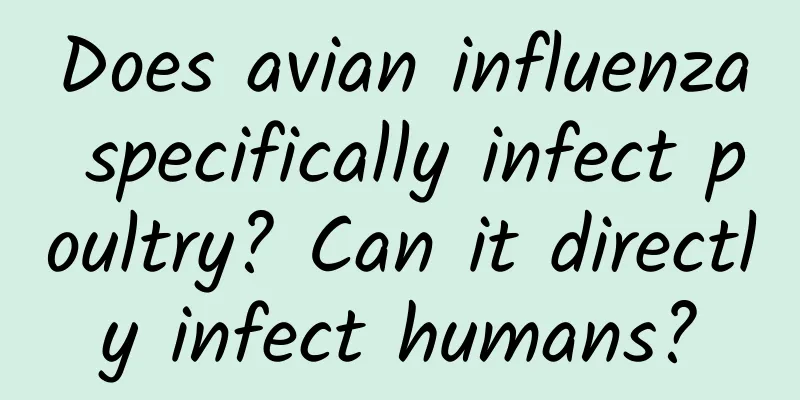Does avian influenza specifically infect poultry? Can it directly infect humans?

|
The full name of avian influenza is avian influenza, which is an infectious disease caused by avian influenza virus. According to the influenza virus classification standards, avian influenza virus belongs to influenza A virus, which is the most susceptible to mutation. And according to its pathogenicity to chickens, it can be divided into three levels: high, medium, and low (or non-) pathogenicity. At present, the avian influenza virus subtypes (different genotypes of the same virus) that have been found to be able to directly infect humans mainly include: H5N1, H7N1, H7N9 and H9N2 subtypes, etc. Among them, H5N1 and H7N9 subtypes are the most serious. Does avian influenza infect only poultry? Of course not! The earliest record of avian influenza can be traced back to the fowl plague in Italy in 1878. Later, in 1901, the culprit was called the filterable factor or fowl plague virus (FPV). The "Spanish flu" that broke out in 1918 infected nearly one billion people and killed nearly 40 million people worldwide in about three years, affecting many regions and countries in North America, Europe, and Asia (it was called "Spanish flu" not because the epidemic started in Spain, but because Spain suffered heavy losses - about 8 million people were infected, and even the king was not spared). After investigation, it was found that the culprit was avian influenza! This pandemic made humans feel the power and horror of avian influenza for the first time. Later, people found that Newcastle disease virus (NDV) can also cause fowl plague-like disease (commonly known as "fowl plague"). Therefore, in order to distinguish the two, the former is called European fowl plague virus or true fowl plague, while the latter is called Asian fowl plague virus or pseudo-fowl plague. It should be noted that not all avian viruses can cause fowl plague, and some can be healthy carriers or silent infections. How did the avian influenza virus appear? This question is really not easy to answer. Because viruses cannot be studied through fossils like plants and animals. As for their origin, it is still at the hypothesis stage. The main theories are: avian influenza virus originated from degenerate organelles, or from degenerate bacteria, or it is the product of the co-evolution of viruses and bacteria. The avian influenza virus belongs to the Orthomyxoviridae family and consists of three parts: nucleocapsid, envelope and spikes. The nucleocapsid is divided into core and capsid. The core is composed of eight strands of RNA, surrounded by a capsid made of protein. The outside of the nucleocapsid is the envelope, which has spikes. There are two types of spikes, one is hemagglutinin (HA) and the other is neuraminidase (NA). In the daily news about bird flu, the H and N in "HxNx" refer to the types of hemagglutinin and neuraminidase mentioned above. Currently, it is believed that there are 15 subtypes of H and 9 subtypes of N, so there are a total of 135 subtypes of HxNx (some say 144 subtypes). Although the avian influenza virus is powerful, it cannot survive alone outside the body and can only reproduce in host cells. In fact, any organism has two needs: survival and development. For avian influenza viruses, development means reproducing more virus individuals, and survival means living longer. However, the resources in cells are limited, and if the number of viruses increases, the host cells will die, so their survival and development are in a dynamic balance. The original bird flu virus may have been lurking in wild birds, and one day it suddenly ran into a flock of chickens and sneezed. It happened that the sneeze contained the bird flu virus, and what was even more coincidental was that the bird flu virus also infected the chickens. So the chickens could only consider themselves unlucky and became the new host of the virus. In addition, since chickens are gregarious animals, this provides a realistic basis for the spread of different avian influenza viruses in the same flock of chickens, and different subtypes of viruses may infect the same host cell at the same time, so that virus recombination may occur in this cell. Taking the H7N9 subtype virus, which is currently the most virulent, as an example, it is a genetic recombination of avian influenza viruses from wild birds in East Asia and avian influenza viruses from chicken flocks in Shanghai, Zhejiang and Jiangsu. According to incomplete statistics, since the discovery of human infection with the H7N9 virus, a total of about 1,600 cases have been reported worldwide, of which more than 750 cases have been reported in mainland China, causing hundreds of deaths. Although avian influenza is unpredictable and extremely severe, humans are constantly summarizing and making progress, and have now proposed prevention and treatment measures that are effective in dealing with human infection with avian influenza. From a prevention perspective, it mainly includes: 1. Control the spread of poultry viruses and improve the safety and hygiene levels of all links in breeding, slaughtering and circulation; 2. Continue to carry out health education and health protection; 3. While strictly monitoring, be prepared to respond to epidemics. In terms of treatment strategies, anti-infection and symptomatic treatment should be carried out as appropriate under appropriate isolation conditions. I believe that with the continuous deepening of research, various "new weapons" and response strategies will surely emerge! END *This article was first published by "The Fat Devil's Microbial Front" (WeChat ID: nldxhjwswx). Any media reprinting must retain the name and WeChat ID of "The Fat Devil's Microbial Front". Any changes, including the title, are strictly prohibited without permission. *Most of the pictures in this article are from the Internet. Please inform us if there is any infringement. Friends are welcome to correct the content, all for better science popularization! |
Recommend
Wild boars are causing harm in 26 provinces! How to prevent wild boars from running wild?
On October 25, a wild boar broke into a roadside ...
BlackBerry also said that it would abandon its mobile phone business if it is not profitable next year
[[151352]] Today, the structure of the mobile pho...
Introduction to Qinggua Media’s intelligent advertising delivery system!
Introduction to Qinggua Media Intelligent Adverti...
The State Administration of Radio, Film and Television revealed new rules for video boxes: Faces cannot be shown on video websites
The radio and television industry is preparing str...
Toyota seeks collaboration to meet future challenges
Recently, according to foreign media reports, Toy...
Haagen-Dazs: The magic weapon of store inspection [WeChat corporate account case]
1. "Store Inspection" Store inspectors ...
What is the monetization positioning of Tik Tok? Introduction to Douyin's money-making model
Friends who operate Douyin can use the Douyin pla...
Programmer, how serious are you about your work other than writing code?
The company arranged a promotion plan in the midd...
Rumor has it that Google has another personnel change: Are Android and Chrome really going to merge?
[[121331]] According to foreign media reports, pe...
Dissecting the “66 Yuan Free Flight” event on Fliggy from the perspective of event planning
Due to the epidemic, major airlines are facing fi...
With just 15 seconds of audio, AI can help aphasics “regain their voice”?
OpenAI shared some of their progress in AI speech...
The world's fifth person cured of AIDS has appeared. Can the method of conquering AIDS be replicated?
On February 20, 2023, researchers from the Univer...
The World Health Organization will announce that Coke, Sprite and chewing gum are carcinogenic? Sausage, ham, beef and mutton have already told you →
On June 29, the topic #AspartameCausesCarcinoma# ...
New media operation: How to create a brand super symbol
In daily life, we often have this experience: mos...









